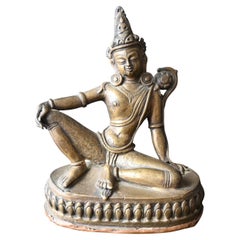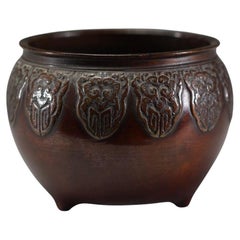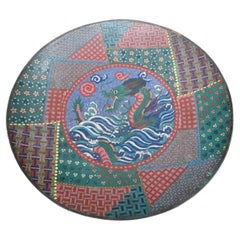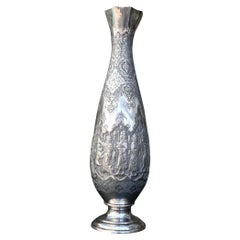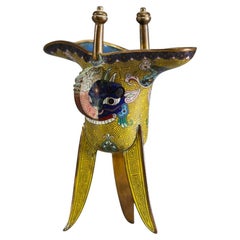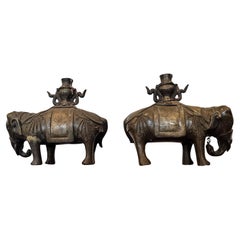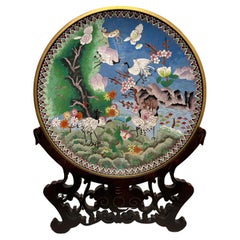Art Classique Metalwork
to
6
6
1
4
1
1
1
6
3
2
1
1
6
4
3
1
1
6
6
6
Bronze Statue Of Nepalese Tara (royal Relaxation Position), Late 19th Century
Located in Bilzen, BE
"Bronze Statue Of Nepalese Tara (royal Relaxation Position), Late 19th Century"
A finely cast bronze figure of Tara, seated in lalitasana (royal ease pose) atop a double-lotus base. ...
Category
Antique Late 19th Century Nepalese Tibetan Metalwork
Materials
Bronze
China, Bronze incense burner with archaic decoration, Qing Dynasty, 19th century
Located in Bilzen, BE
China, Bronze incense burner with archaic decoration, Qing dynasty.
Brown original patina and traces of aged use
19th century
Diameter body 10.5 cm, heigth 8 cm
Category
Antique 19th Century Chinese Qing Metalwork
Materials
Bronze
Antique japanese forged iron tsuba from the Edo period
Located in Bilzen, BE
A forge iron Japanese samurai tsuba from the Edo period (1603 - 1868)
Katana tsuba 7.5 x 7.5 cm
Good condition as shown in the pictures uncleaned with its old patina
Category
Antique 18th Century Japanese Edo Metalwork
Materials
Iron
Large Chinese Cloisonné Enamel on brass Dish 19th Century
Located in Bilzen, BE
A large Chinese cloisonné dish with dragon decoration from the 19th century
Good condition, no chips or loose enamel parts
Diameter 36.5 cm
Cloisonné is an ancient technique for dec...
Category
Antique 19th Century Chinese Qing Metalwork
Materials
Brass, Enamel
Museum Quality Antique Islamic Qajar Indo-persian Silver Vase
Located in Bilzen, BE
A museum quality antique silver vase from the end of the 19th century .
This heavy sterling silver vase is fully decorated and engraved with a breathtaking arabesque design with ...
Category
Antique Late 19th Century Turkish Islamic Metalwork
Materials
Silver
20th C. Chinese Bronze and cloisonné enamel wine cup for ritual ceremonies
Located in Bilzen, BE
China - Bronze and cloisonné enamel wine cup for ritual ceremonies with archaic Jue decoration, body decorated with a Chilong head early 20th c
Heigth 15.5 cm
Category
Vintage 1920s Chinese Qing Metalwork
Materials
Bronze, Enamel
Related Items
Pair 18th/19th Century Chinese Bronze Elephant Figure Candle Holder Sculptures
Located in Forney, TX
A pair of finely cast and incised burnished bronze candlestick elephants, Chinese school, 18th-19th Century, Qing Dynasty (1636-1912).
Each elephant is standing foursquare with head...
Category
Antique Early 19th Century Chinese Qing Metalwork
Materials
Bronze
$950 / set
H 6 in W 8 in D 3 in
Large Chinese Enamel Bronze Cloisonne Charger
Located in Norwood, NJ
Large Chinese enamel bronze cloisonne charger. Unusual and rare bronze Chinese Cloisonne charger. The brightly multicolored enamel decoration feature...
Category
Late 20th Century Chinese Metalwork
Materials
Bronze, Enamel
19th Century Chinese Cloisonné Fu Dogs
Located in Houston, TX
An exceptional palatial quality pair of 19th century Chinese cloisonné Fu dogs featuring gold gilding over copper.
Chinese cloisonné o...
Category
Antique 1890s Chinese Chinese Export Metalwork
Materials
Copper, Enamel
18th Century Chinese Qing Bronze Duck Incense Burner Sculpture
Located in Haddonfield, NJ
18th Century Chinese bronze duck incense burner, Qing period
Please note that one foot is missing, broken off, see detailed image.
Category
Antique Early 18th Century Chinese Qing Animal Sculptures
Materials
Bronze
Chinese Bronze Mirror with Cast Relief Dragon, Late 19th Century
Located in Chicago, IL
This antique Chinese mirror is cast of bronze in the tang-dynasty style, with a lobed rim of eight flower petals, each filled with small cloud ...
Category
Antique Late 19th Century Chinese Qing Metalwork
Materials
Bronze
Chinese Cloisonne Incense Tool Vase, Qing Dynasty, 18th/19th Century, China
Located in Austin, TX
A small and elegant Chinese cloisonné vase for incense tools, Qing Dynasty, 18th/19th century, China.
Made for the scholar's studio, this small refined vase, was used to hold incense tools, including a small pair of tongs or chopsticks and spoon. The tools no longer present.
Of miniature baluster vase form, the vase beautify proportioned and decorated in the cloisonné enamel technique, with gilt wires forming the cloisons, or partitions. Within the cloisons, colorful enamels have been expertly laid.
The small incense tool vase...
Category
Antique Early 1800s Chinese Qing Scholar's Objects
Materials
Copper, Enamel
$6,800
H 3.75 in Dm 1.75 in
Antique Islamic Brass Bowl Fine Metalwork Hand Etched Bowl
Located in North Hollywood, CA
Antique Middle Eastern Islamic art Moorish brass bowl engraved with Thuluth Arabic calligraphy.The polished brass bowl is profusely chased with vines and vegetal motifs and inscribed with Islamic verses of the Holly Koran.This bowl has been professionally cleaned and polished.Measures: Diameter 7.25" x 4" height Mouth opening: 5".Great Middle Eastern brass metalwork decorative Islamic art objects.Handcrafted Moorish hand-etched Islamic metal brass bowl.Engraved, incised and hammered with very fine Arabic Islamic calligraphy writing and geometric designs on brass vessel.Very Intricate fine Middle eastern Moorish Islamic Art metalwork, museum quality artwork.Late 19th Century.Date of Manufacture: Circa 1880.Condition: Wear consistent with age and use.
Islamic brass metalwork is an intricate and beautiful form of art that originated in the Islamic world. It encompasses a wide range of decorative objects made from brass or other metals such as copper, bronze, and silver. Brass trays, in particular, are highly regarded for their craftsmanship and intricate designs.
Islamic brass metalwork has a rich history that dates back to the early Islamic period, with its roots in the metalworking traditions of ancient civilizations such as the Persians, Greeks, and Romans. However, Islamic artisans developed their own unique styles and techniques, blending elements from various cultures and creating distinctive motifs that reflected Islamic aesthetics and religious beliefs.
The process of creating brass trays involves several steps, each requiring specialized skills. Here is a general overview of the traditional techniques involved:
1) Design: A skilled artist or calligrapher creates the design for the brass object. Islamic brass metalwork often incorporates intricate geometric patterns, arabesques, floral motifs, and calligraphy inspired by Quranic verses or poetry.
2) Metalworking: The object is typically made from a sheet of brass or another metal. The metal is cut into the desired shape and then hammered or pressed to create the object. Traditional techniques such as repoussé (hammering from the reverse side) or chasing (hammering on the front side) may be employed to shape the metal.
3) Engraving: The surface of the metal is often decorated with intricate engravings or etchings. Skilled artisans use chisels, gravers, or other specialized tools to create fine details and elaborate patterns.
4) Filigree and Inlay: Some brass trays feature additional decorative elements such as filigree or inlay work. Filigree involves shaping thin wires of brass into delicate patterns and soldering them onto the tray's surface. Inlay work, on the other hand, involves embedding contrasting materials such as silver or copper into the brass, creating intricate designs.
5) Surface Treatment: After the main decorative work is complete, the tray may undergo surface treatments to enhance its appearance. This can include processes like polishing, buffing, or applying various chemical patinas to create an aged or oxidized effect.
While this bowl has certainly witnessed the passage of time, it remains in remarkably good condition, with only minor signs of age that add character to its appearance. The patina on the brass enhances its antique allure, making it a truly authentic and captivating collectible.
Arabic Calligraphy: The Arabic writing on the bowl is a work of art in itself. The calligraphy showcases the mastery of the scribe's hand, with flowing curves and intricate details that form an elegant script. The script may include Quranic verses, blessings, or poetic verses, depending on the bowl's origin and purpose. The inscriptions are not only visually striking but also carry profound meaning, making this bowl a beautiful representation of Islamic heritage.
Intricate Patterns: In addition to the Arabic calligraphy, the bowl features intricate geometric patterns and motifs that further enhance its visual appeal. These patterns are a hallmark of Islamic art and reflect the mathematical precision and artistic creativity that defined Islamic craftsmanship.
This antique Islamic brass bowl...
Category
Antique 19th Century Turkish Islamic Metalwork
Materials
Brass
Islamic Indo Persian Kulah Khud Helmet with Arabic Inscription
Located in North Hollywood, CA
Islamic Indo Persian kulah khud helmet with Arabic hand engravings.
Hand forged, made of heavy tinned copper metal Middle eastern influence warrior helmet ...
Category
Early 20th Century Indian Islamic Metalwork
Materials
Metal, Steel
Chinese Ormolu and Cloisonné Enamel Vase for the Islamic Market
Located in London, GB
Chinese Ormolu and cloisonné enamel vase for the Islamic Market
Chinese, early 20th century
Dimensions: Height 18cm, diameter 25cm
Crafted in China...
Category
Early 20th Century Chinese Chinese Export Metalwork
Materials
Bronze, Enamel, Ormolu
$4,947 Sale Price
20% Off
H 7.09 in Dm 9.85 in
Chinese Floral Cloisonné Enamel and Ormolu Vase for Islamic Market
Located in London, GB
Chinese Floral Cloisonné enamel and ormolu vase for Islamic Market
Chinese, early 20th century
Dimensions: Height 21cm, diameter 24cm
This beautifu...
Category
Early 20th Century Chinese Chinese Export Metalwork
Materials
Bronze, Enamel, Ormolu
$4,947 Sale Price
20% Off
H 8.27 in Dm 9.45 in
Japanese Parcel Gilt Copper Hibachi, Edo Period, 18th Century, Japan
Located in Austin, TX
A sublime Japanese parcel gilt copper hand warmer, hibachi, with chrysanthemum design, Edo Period, 18th century, Japan.
The hand warmer, called a...
Category
Antique 18th Century Japanese Edo Metalwork
Materials
Copper
Antique Japanese Meiji Period Tsuba Decorated Box and Dish by Fujii Yoshitoyo
By Fujii Yoshitoyo
Located in Newark, England
Original Box and Dish Pair
From our Japanese collection, we are pleased to offer this Japanese Komai Style Box and Dish Fujii Yoshitoyo. The Box of slim rectangular shape seated upo...
Category
Antique Late 19th Century Japanese Meiji Metalwork
Materials
Metal
$3,091
H 1.78 in W 5.12 in D 4.34 in
